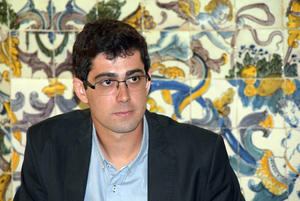
Doutoramento Engenharia Mecatrónica e Energia
Soiling in Solar Energy Conversion Technologies: Assessment and Mitigation
Ricardo Filipe Carrão da Conceição

Orientação : Hugo Manuel Gonçalves Silva & Manuel Collares Pereira
Soiling, the process of particle deposition onto surfaces, has been studied since the 40’s. Initially, it was studied as a physical process, including types of adhesion forces, and latter its effect on performance of solar energy conversion technologies was analyzed, such as in photovoltaics and concentrated solar power. This thesis approaches the problem from a cause-effect point of view and how it can be mitigated. Soiling is characterized, mineral and chemically, using a Scanning Electron Microscope. Polycristalline photovoltaic modules deposition rates are retrieved and related to environmental parameters, as well as, to long-range Saharan desert dust transport, a non-local phenomenon. Attention is also given to Spring, where atmospheric pollen concentration enhances soiling. The effect of soiling on the photovoltaic optimum tilt angle, for fixed and multiple angles, is studied along with a simple economic analysis. Cleaning schedules, for a desired system efficiency, are calculated based on annual soiling. Mirror soiling, related to concentrated solar power technologies, is also analyzed. Soiling rates are calculated and interlinked with environmental parameters such as air temperature, relative humidity, particulate mater concentration and vertical wind speed. From a collaboration with the Institut de Recherche en Energie Solaire et Energies Nouvelles, Morocco, an insightful study is made comparing soiling effect between Portugal and Morocco. A passive cleaning method, impregnated anti-soiling coating, is tested. Comparison between coated and uncoated mirrors is done to evaluate its performance and conclude if it stands as a possible tool to reduce water consumption in cleaning solar harvesting technologies.
Soiling, the process of particle deposition onto surfaces, has been studied since the 40’s. Initially, it was studied as a physical process, including types of adhesion forces, and latter its effect on performance of solar energy conversion technologies was analyzed, such as in photovoltaics and concentrated solar power. This thesis approaches the problem from a cause-effect point of view and how it can be mitigated. Soiling is characterized, mineral and chemically, using a Scanning Electron Microscope. Polycristalline photovoltaic modules deposition rates are retrieved and related to environmental parameters, as well as, to long-range Saharan desert dust transport, a non-local phenomenon. Attention is also given to Spring, where atmospheric pollen concentration enhances soiling. The effect of soiling on the photovoltaic optimum tilt angle, for fixed and multiple angles, is studied along with a simple economic analysis. Cleaning schedules, for a desired system efficiency, are calculated based on annual soiling. Mirror soiling, related to concentrated solar power technologies, is also analyzed. Soiling rates are calculated and interlinked with environmental parameters such as air temperature, relative humidity, particulate mater concentration and vertical wind speed. From a collaboration with the Institut de Recherche en Energie Solaire et Energies Nouvelles, Morocco, an insightful study is made comparing soiling effect between Portugal and Morocco. A passive cleaning method, impregnated anti-soiling coating, is tested. Comparison between coated and uncoated mirrors is done to evaluate its performance and conclude if it stands as a possible tool to reduce water consumption in cleaning solar harvesting technologies.
Keywords: Solar Energy, Conversion Technologies, Soiling, Modeling, Mitigation




